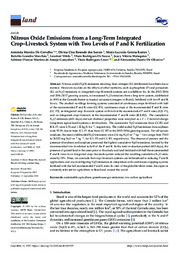Nitrous oxide emissions from a long-term integrated crop-livestock system with two levels of P and K fertilization.
Nitrous oxide emissions from a long-term integrated crop-livestock system with two levels of P and K fertilization.
Author(s): CARVALHO, A. M. de; SANTOS, D. C. R. dos; RAMOS, M. L. G.; MARCHAO, R. L.; VILELA, L.; SOUSA, T. R. de; MALAQUIAS, J. V.; GONÇALVES, A. D. M. de A.; COSER, T. R.; OLIVEIRA, A. D. de
Summary: Abstract: Nitrous oxide (N2O) emissions resulting from nitrogen (N) fertilization have been docu- mented. However, no data on the effects of other nutrients, such as phosphate (P) and potassium (K), on N2O emissions in integrated crop?livestock systems are available so far. In the 2015/2016 and 2016/2017 growing seasons, we measured N2O emissions from a long-term system, established in 1991 in the Cerrado biome (a tropical savanna ecoregion in Brazil), fertilized with two P and K levels. The studied no-tillage farming systems consisted of continuous crops fertilized with half of the recommended P and K rates (CC-F1), continuous crops at the recommended P and K rates (CC-F2), an integrated crop?livestock system with half of the recommended P and K rates (ICL-F1), and an integrated crop?livestock at the recommended P and K rates (ICL-F2). The cumulative N2O emissions (603 days) and soil chemical properties were analyzed as a 2 × 2 factorial design (long-term agricultural systems x fertilization). The cumulative N2O emissions from CC-F2 and ICL-F1 were 2.74 and 1.12 kg N ha−1, respectively. The yield-scaled N2O emissions from soybean were 55.5% lower from ICL-F1 than from CC-F2 in the 2015/2016 growing season. For off-season sorghum, the mean yield-scaled N2O emissions were 216 mg N2O m−2 kg−1 (in a range from 79.83 to 363.52 mg N2O m−2 kg−1, for ICL-F2 and CC-F1, respectively). The absence of pasture and the presence of soybean and sorghum promoted the highest cumulative N2O emissions, favored by the recommended rate in relation to half of the P and K. In the total evaluation period (603 days), the presence of grazed land in the years prior to this study and land fertilized with half the recommended P and K rates in an integrated crop?livestock system reduced the resulting cumulative N2O emis- sions by 59%. Thus, we conclude that crop?livestock systems can be beneficial in reducing P and K applications and also in mitigating N2O emissions in comparison with continuous cropping systems fertilized with the full recommended P and K rates. In view of the global fertilizer crisis, this aspect is extremely relevant for agriculture in Brazil and around the world.
Publication year: 2022
Types of publication: Journal article
Unit: Embrapa Cerrados
Observation
Some of Embrapa's publications are published as ePub files. To read them, use or download one of the following free software options to your computer or mobile device. Android: Google Play Books; IOS: iBooks; Windows and Linux: Calibre.
Access other publications
Access the Agricultural Research Database (BDPA) to consult Embrapa's full library collection and records.
Visit Embrapa Bookstore to purchase books and other publications sold by Embrapa.

